
You can integrate Process Street with Google Sheets, using Process Street’s Automations.
This integration allows you to send data collected in your workflow runs automatically into a new row in a Google Sheet, either when a task is checked or when a workflow run is completed.
Users: In order to create or update Automations, you must be an Administrator or a Member with “edit” permissions.
Before you get started you’ll need to have a few things set up in Google Sheets and in your Process Street workflow.


Now you’re ready to go ahead and start creating your automation!
When viewing the workflow you will see the “Triggers and Automations” button below your workflow name. Click on the + button and create the automation with your Google Sheet, as shown below.
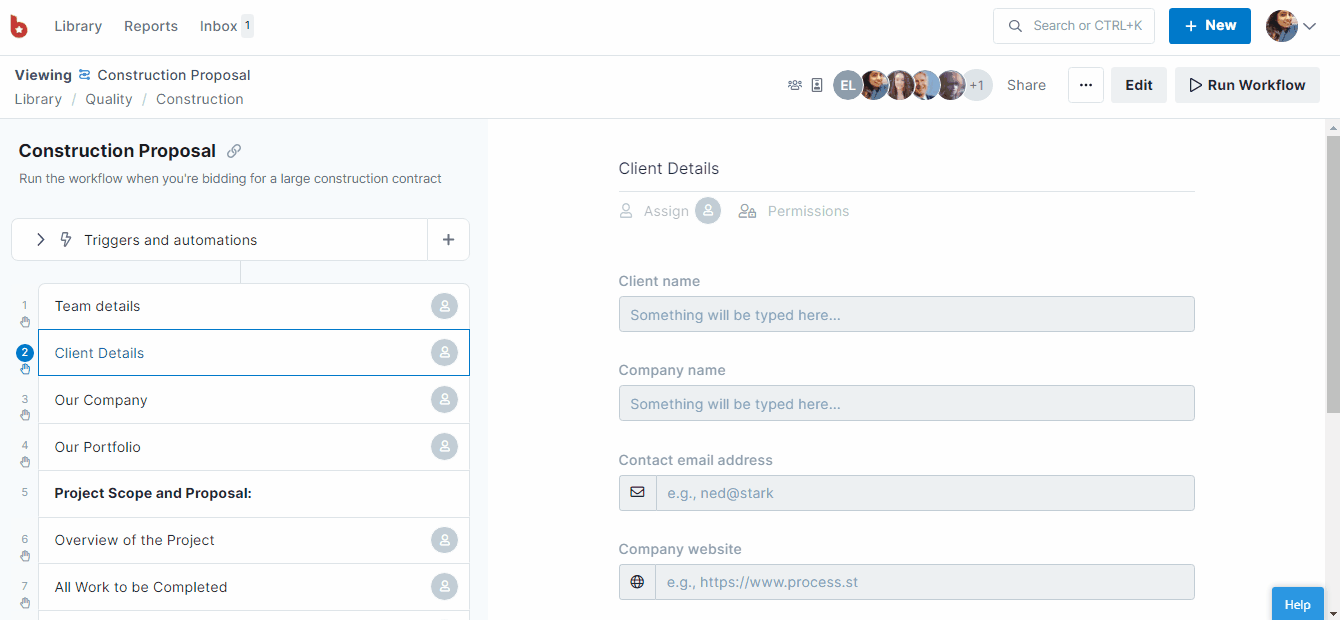
Note: Your Google Sheet must be located in “My Drive” for your automation to work, i.e you must be the owner of the sheet to create an automation with it.
Start by selecting the trigger for your automation.
For Google Sheets automations, you can choose from these two triggers:
Click the + button on your chosen trigger to get started.
Let’s walk through examples for each of these triggers and their respective actions.
In this example, completing a task in our construction proposal workflow run adds a new row of data into a Google Sheet so that all projects can be tracked, costs estimated and reported on.
Select “When a task is checked” from the left side of your screen.
Start by selecting the task in your workflow that will act as your trigger.
Next, click the Google Sheets icon and a small tick will appear to confirm your selection.
Select the action “add a row to a Google Sheet”.


When you select the action, you will be prompted to choose a Google account to run your automation through, as shown above.
If it’s the first time you are connecting to Google Sheets via Process Street, click “New authentication” and another pop-up window will appear for you to be able to create a new authentication.
Note: You will need to disable pop-ups blockers to allow you to authorize an app.
Select the permissions to allow:
If you already have an account connected, then you can continue with the one shown, or select another account to add.
Select the name of the sheet you would like to pass data into and click “Next”.

Note: Your sheet will need to be in “My Drive” and not a shared drive, for example.
Select the tab or individual sheet you would like to update within this document.
Next, you need to map the fields from your workflow run, that you would like to pull into your Google Sheet.
These could be global variable fields like Workflow Run Name, Workflow Run URL, Task Name, or they could be the names of form fields that you added into your workflow.

Click “Add a new mapping” to map more fields from your workflow run to your sheet. When you’re done mapping fields, click “Next”.
Optional: If you would like to capture the range of your newly created sheet row, in your workflow run, you can do that by adding a form field such as a website form field into it.

Once that’s added, you can use this step to capture a link to the new record you created in Google Sheets.
Or if you prefer to skip this part, click “Finish”.
Now you’re ready to turn on your automation. Use the toggle switch to turn it on.

Now every time your task is checked, a new row of data from your Process Street workflow run will be added to your chosen Google sheet.
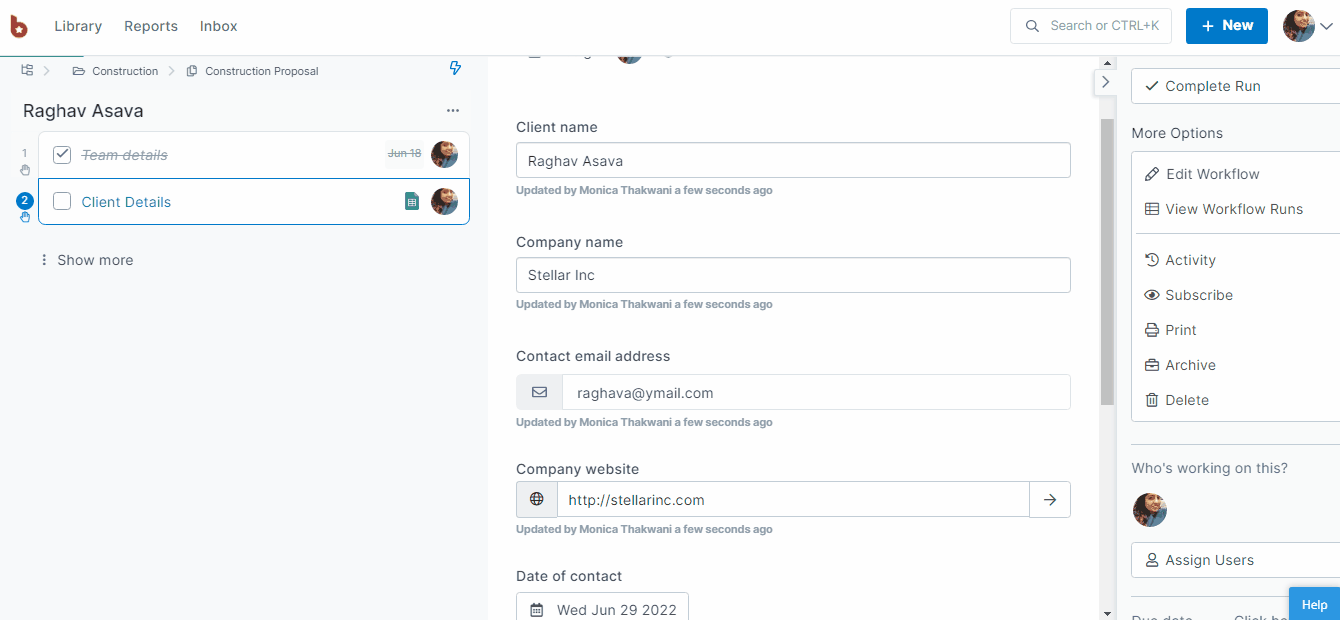
In this example, completing a workflow run from our employee onboarding process sends links for files the candidate has shared with us, into a Google Sheet.
Navigate to “Triggers and Automations” below the workflow name and click on the + button. Then select Google Sheets as the app to automate with.
Next, “When a workflow run is complete” from the available triggers.
Select the action “add values to a spreadsheet”.

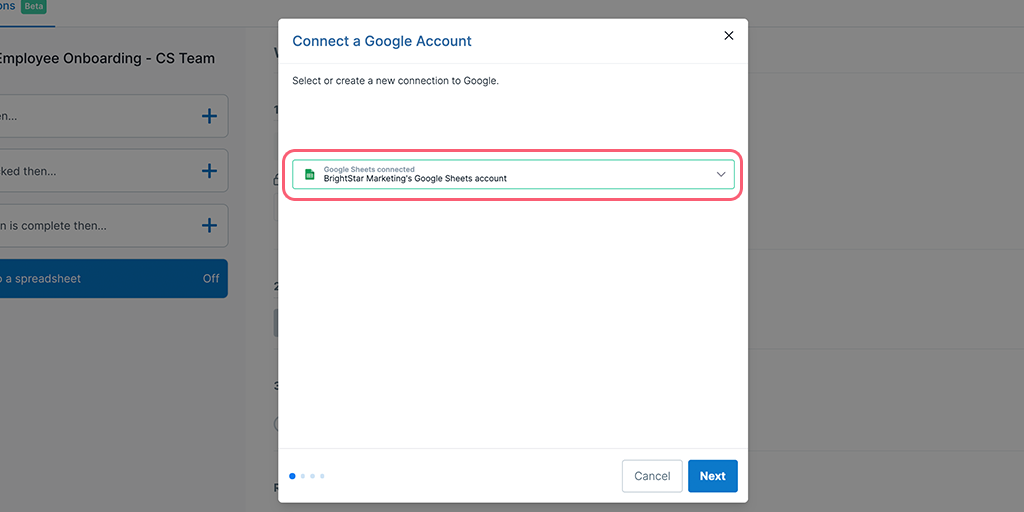
When you select the action, you will be prompted to choose an account to run your automation through.
If it’s the first time you are connecting to Google Sheets via Process Street, click “New authentication” and another pop-up window will appear for you to be able to create a new authentication.
Note: You will need to disable pop-ups blockers to allow you to authorize an app.
If you already have an account connected, then you can continue with the one shown, or select another account to add.
Select the name of the sheet you would like to pass data into and click “Next”.

Note: Your sheet will need to be in “My Drive” and not a shared drive, for example.
Select the tab or individual sheet you would like to update within this document. Click “Next”.
Next, you need to map the fields from your workflow run, that you would like to pull into your Google Sheet. These could be global variable fields like Workflow Run Name, Workflow Run URL, Task Name, or they could be the names of form fields that you added into your workflow.

Click “Add new mapping” to map more fields from your workflow run to your sheet. When you’re done mapping fields, click “Finish”.
Now you’re ready to turn on your automation. Use the toggle switch shown below, to switch it on.
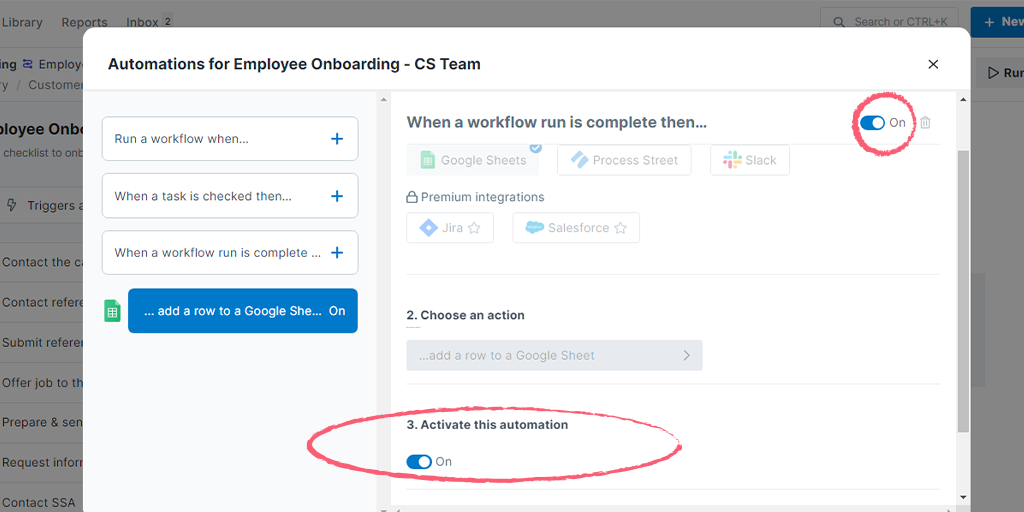
Now every time your workflow run is completed, a new row of data from your Process Street run will be added to your chosen Google sheet.

If you’re looking to create a more advanced integration with Google Sheets, you might consider sending a link for your updated sheet, to your sales or finance team in Slack. You can do this by adding a Slack automation into your workflow.
You can also embed your sheet into another workflow so that you can refer to it from other processes, or run multiple workflow runs from a CSV of your sheet data.
To be able to edit the fields you have mapped in your automation, or change the triggers or actions, you first need to turn off your automation using one of the toggle switches.
To remove an automation from a workflow, you can delete it, but first, you will need to ensure that it has been switched off. Turn the toggle switch to the “off” position and then click the trashcan icon in the top right of your view to delete the automation.
There are no filters, delays, or formulas built into automations at the moment. To be able to utilize these types of functions, you might want to consider using a Zapier integration instead.
If you would like to request that we add another app to our automations, you can do that from the help button in the bottom right corner of your screen. Click “Suggestions” and send us your request.
If your automation stopped running, isn’t working as expected, or is showing errors, there might be a few reasons for this. Please check the following:
You can check your automation run logs to see how your automations are running, or check for errors. You will find the automation run logs in two places, on your workflow or on workflow runs.
In your workflow on the automations tab, select an existing automation from the left side of your screen (highlighted in blue below). At the bottom of your page, you will see a list of all of the automation runs for that workflow. If your automation hasn’t run yet, you’ll see something similar to the below.
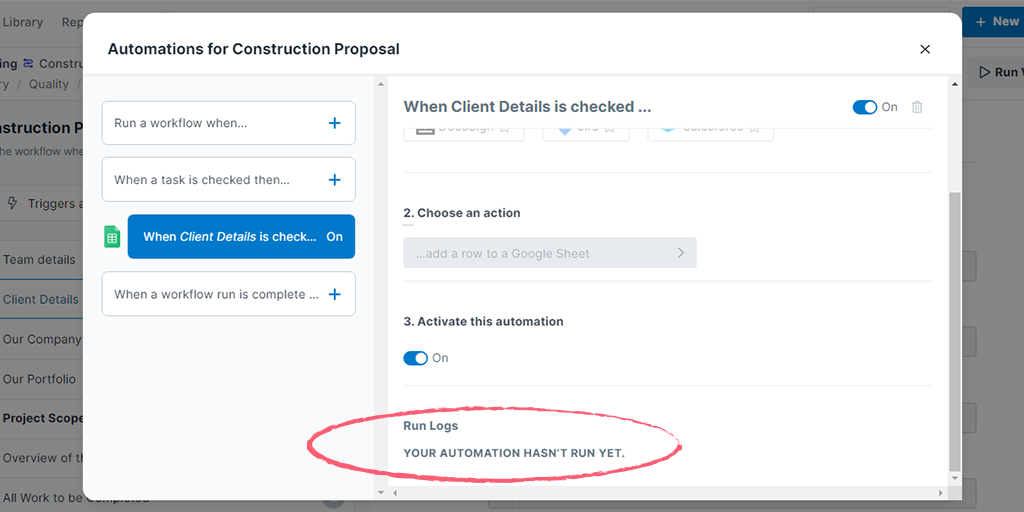
In a workflow run, in the upper right-hand corner of your task list, you’ll see the lightning bolt icon![]() . Click the icon to see the run logs for that particular workflow run.
. Click the icon to see the run logs for that particular workflow run.
If you have any errors, click the word “Error” to expand more information on why your automation didn’t run.

The lightning bolt icon will only show up on workflow runs that have automations configured on them. This is an automation’s idle state.
When an automation is running, you’ll see the bolt change to the ![]() icon.
icon.
Once the automation finishes running, you’ll see either ![]() for success or
for success or ![]() for failure. If it’s a failure, you can click on the X to see the run logs and then click on the “Error” log for more information.
for failure. If it’s a failure, you can click on the X to see the run logs and then click on the “Error” log for more information.
If you have any questions about using Automations, please reach out to our Process Pros team.